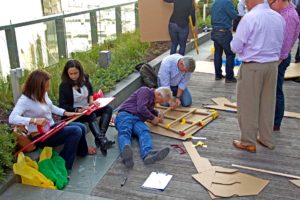 In our last post, we discussed one of business’s current buzzwords, design thinking. This is a process of problem-solving developed in the design world which takes an approach focusing on the end-user, with an emphasis on prototyping and testing. It’s a really effective way of looking at problems and devising solutions that might have otherwise been outside of your realm of thinking.
In our last post, we discussed one of business’s current buzzwords, design thinking. This is a process of problem-solving developed in the design world which takes an approach focusing on the end-user, with an emphasis on prototyping and testing. It’s a really effective way of looking at problems and devising solutions that might have otherwise been outside of your realm of thinking.
Undertaking a new process for anything in business can feel like a risky proposition. When we are dealing with real-world deadlines and the pressures of keeping clients, both internal and external, happy, it can be hard to experiment with something new.
For us, this is one of the most compelling reasons for team building activities. They provide a safe proxy for real world problem-solving, while relieving us of that incessant fear of failure. Team building exercises allow us to experiment with processes and behaviors that we’re not accustomed to in order to test out their effectiveness. Design thinking is a great example of a process we’re seeing more and more teams test out.
To briefly reiterate from our last post, the stages of design thinking are as follows:
- Empathize: Develop an understanding of your end-user (the recipient of your solution) and connect with them about the problem they’re facing on an emotional level.
- Define: Analyze your findings from talking with your end-user about their problems and try to distil the issue into one simple, easy-to-understand, and impactful sentence.
- Ideate: Reach far and wide for ideas about how to solve the problem. Don’t hold back or filter, you want to stretch. Eventually, pick a few front runners that have different strengths (ie, most likely to delight, most unexpected, etc)
- Prototype: Start getting crafty and create some very simple prototypes (think cardboard, paper, and markers, re-purpose office items as stand-ins). Try to create an experience, and get feedback in real time from end-users.
- Test: This goes hand-in-hand with prototyping – but the point is that you continually test your creations until you’ve either found a great option or gone back to testing alternate ideas.
Some of our more creative team building programs really lend themselves to this process, like Build a Boat, Build a Bridge, and Lego Landmarks. In the case of Build a Boat, teams are trying to create an attractive and well-performing boat made of cardboard and an assortment of other supplies, like vinyl sheeting, duct tape, and cardboard tubes. There are specs for the build—it must be a boat (not a raft), it must be self-propelled (not tugged along), and it must be built using only supplied materials (which materials you choose to use within this allotment is up to you, though).
Now a team might normally just attack this problem headlong, immediately drawing up a rough sketch and then cutting up some cardboard after a rough consensus on the design. But how could this process incorporate design thinking?
First off, who are your end-users? In this case, they might be both the judge (who’s looking at aesthetics and adherence to specs) as well as the person actually manning the ship. Does this person have a preference for sitting or kneeling? Does she have long arms, or is she a borderline t-rex? As for the judge, what do we know about him? Does he have a love of Greek mythology? Or is he more into Thor and the fearsome Vikings? This could help us design something that he loves.
Once you’ve used the empathy stage to get some more knowledge about the solution you’re seeking, it’s time to come up with ideas, which you should then test and iterate on. Create a paddle and hand it off to your pilot to see if it feels comfortable. To long? Too short? Too flimsy? Have her sit on the piece of cardboard that makes up the floor of the boat – is it wide enough to allow movement? After this, refine, tweak, and test your approach until you get things right. In this way you can easily apply the principles of design thinking to solving a problem during team building—all while having a great time in the process, and without the pressure of real-world consequences.
- Team Building Lessons – How Much Time Should We Spend Planning? - May 7, 2018
- Team Building Lessons – Do We Try a New Approach? - May 2, 2018
- Team Building Lessons - May 2, 2018
Interested in learning more about our team building and training options?
We'd love to talk to you!
Request Proposal



Leave a Reply